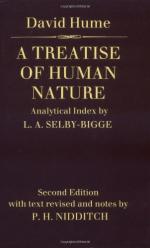SECT. VIII OF BEAUTY AND DEFORMITY
Whether we consider the body as a part of ourselves, or assent to those philosophers, who regard it as something external, it must still be allowed to be near enough connected with us to form one of these double relations, which I have asserted to be necessary to the causes of pride and humility. Wherever, therefore, we can find the other relation of impressions to join to this of ideas, we may expect with assurance either of these passions, according as the impression is pleasant or uneasy. But beauty of all kinds gives us a peculiar delight and satisfaction; as deformity produces pain, upon whatever subject it may be placed, and whether surveyed in an animate or inanimate object. If the beauty or deformity, therefore, be placed upon our own bodies, this pleasure or uneasiness must be converted into pride or humility, as having in this case all the circumstances requisite to produce a perfect transition of impressions and ideas. These opposite sensations are related to the opposite passions. The beauty or deformity is closely related to self, the object of both these passions. No wonder, then our own beauty becomes an object of pride, and deformity of humility.
But this effect of personal and bodily qualities is not only a proof of. the present system, by shewing that the passions arise not in this case without all the circumstances I have required, but may be employed as a stronger and more convincing argument. If we consider all the hypotheses, which have been formed either by philosophy or common reason, to explain the difference betwixt beauty and deformity, we shall find that all of them resolve into this, that beauty is such an order and construction of parts, as either by the primary constitution of our nature, by custom, or by caprice, is fitted to give a pleasure and satisfaction to the soul. This is the distinguishing character of beauty, and forms all the difference betwixt it and deformity, whose natural tendency is to produce uneasiness. Pleasure and pain, therefore, are not only necessary attendants of beauty and deformity, but constitute their very essence. And indeed, if we consider, that a great part of the beauty, which we admire either in animals or in other objects, is




